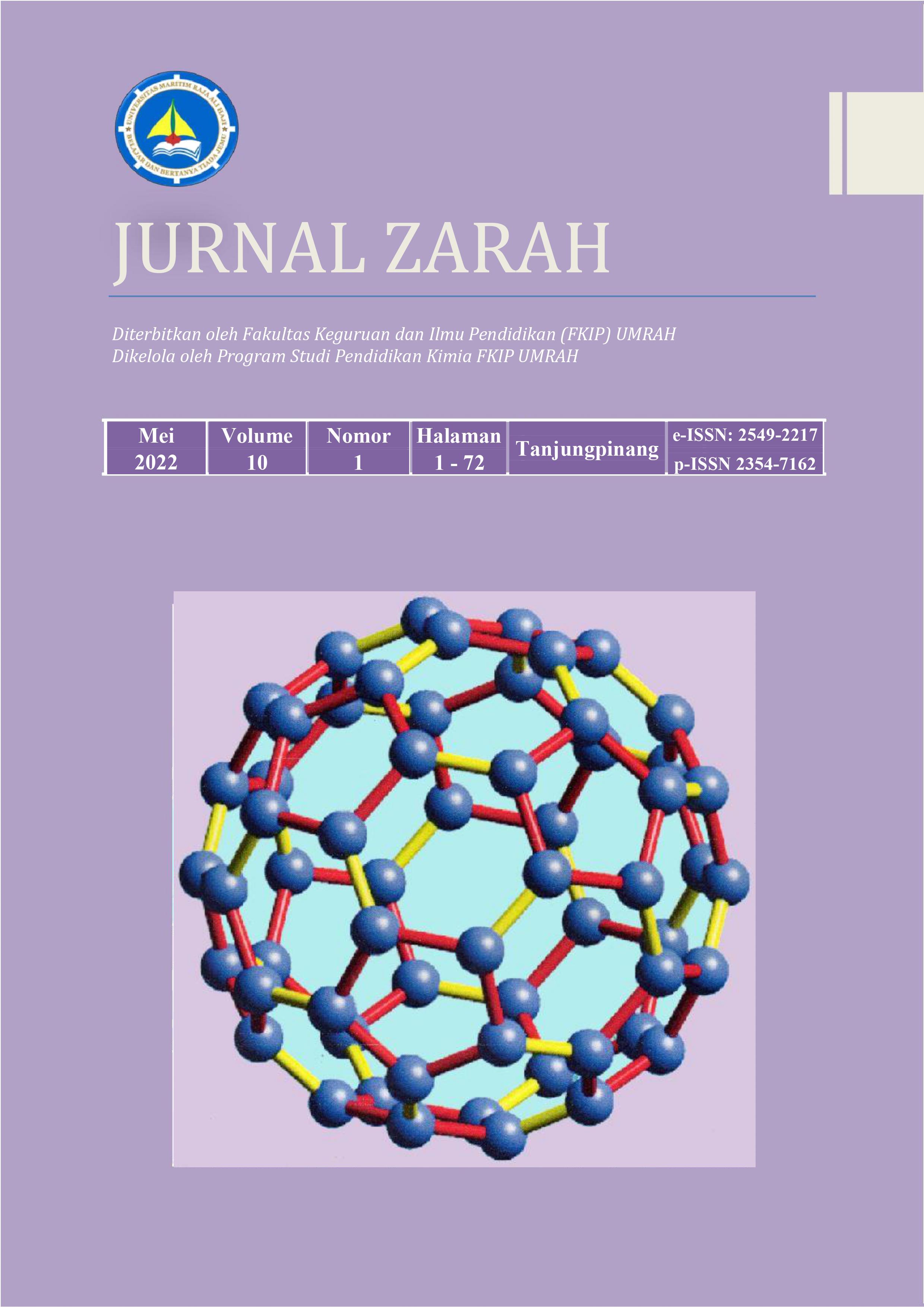PENGEMBANGAN INSTRUMEN TES PENGUASAAN KONSEP SENYAWA ALKIL HALIDA: ANALISIS VALIDITAS MODEL RASCH
DOI:
https://doi.org/10.31629/zarah.v10i1.4161Keywords:
alkil halida, instrumen tes, kimia organik, model Rasch, uji validitasAbstract
Pengembangan tes dalam bentuk bentuk butir soal pilihan ganda sebanyak 13 soal, bertujuan untuk mengukur kemampuan siswa pada pokok bahasan alkil halida. Penelitian menggunakan metode kuantitatif deskriptif. sebanyak 92 mahasiswa yang telah mempelajari senyawa alkil halida dari mata kuliah kimia organik. Kelayakan yang dianalisis dengan model Rasch pada program Winsteps, meliputi tingkat kesulitan soal, validitas aitem, validitas konstruk, validitas konten, dan reliabilitas instrumen. Diperoleh hasil sebaran tingkat kesulitan soal yang merata, sehingga dapat mengukur kemampuan siswa di berbagai level pengetahuan. Validitas konstruk dibuktikan dengan nilai raw variance sebesar 40,2%, dan validitas konten menunjukkan soal-soal fit dengan model Rasch. kelayakan instrumen juga terlihat dari nilai relibilitasnya yang sangat baik yakni 0,96. Soal-soal yang dikembangkan, dapat menjadi alat ukur keberhasikan perkuliahan kimia organik, khususnya pada pembahasan senyawa alkil halida.
Downloads
References
Arellano, D. C.-R., & Towns, M. H. (2014). Students’ understanding of alkyl halide reactions in undergraduate organic chemistry. Chemistry Education Research and Practice, 15(4), 501–515. https://doi.org/10.1039/c3rp00089c
Boone, W. J. (2016). Rasch analysis for instrument development: Why,when,and how? CBE Life Sciences Education, 15(4). https://doi.org/10.1187/cbe.16-04-0148
Cohen, L., Manion, L., & Morrison, K. (2018). Research Methods in Education 8th Edition (8th ed.). Routledge Taylor & Francis Group. http://library1.nida.ac.th/termpaper6/sd/2554/19755.pdf
Crucho, C. I. C., Avó, J., Diniz, A. M., & Gomes, M. J. S. (2020). Challenges in teaching organic chemistry remotely. Journal of Chemical Education, 97(9), 3211–3216. https://doi.org/10.1021/acs.jchemed.0c00693
Davidowitz, B., & Potgieter, M. (2016). Use of the Rasch measurement model to explore the relationship between content knowledge and topic-specific pedagogical content knowledge for organic chemistry. International Journal of Science Education, 38(9), 1483–1503. https://doi.org/10.1080/09500693.2016.1196843
Fung, F. M., & Lam, Y. (2020). How COVID-19 Disrupted Our “flipped” Freshman Organic Chemistry Course: Insights Gained from Singapore. Journal of Chemical Education, 97(9), 2573–2580. https://doi.org/10.1021/acs.jchemed.0c00590
Graulich, N., & Bhattacharyya, G. (2017). Investigating students’ similarity judgments in organic chemistry. Chemistry Education Research and Practice, 18(4), 774–784. https://doi.org/10.1039/c7rp00055c
Graulich, Nicole, & Schween, M. (2018). Concept-Oriented Task Design: Making Purposeful Case Comparisons in Organic Chemistry. Journal of Chemical Education, 95(3), 376–383. https://doi.org/10.1021/acs.jchemed.7b00672
Hartanto, S., & Fordiana, R. (2018). Learning Needs Analysis of Vocational HighSchooìS Chemical Subjects in Mechanical Engineering Department. International Journal of Engineering & Technology, 7, 656–658. http://www.rsc.org/globalassets.
Howitz, W. J., Guaglianone, G., & King, S. M. (2020). Converting an organic chemistry course to an online format in two weeks: Design, implementation, and reflection. Journal of Chemical Education, 97(9), 2581–2589. https://doi.org/10.1021/acs.jchemed.0c00809
Jin, Y., Rodriguez, C. A., Shah, L., & Rushton, G. T. (2020). Examining the psychometric properties of the redox concept inventory: A Rasch approach. Journal of Chemical Education. https://doi.org/10.1021/acs.jchemed.0c00479
Ling Lee, W., Chinna, K., & Sumintono, B. (2020). Psychometrics assessment of HeartQoL questionnaire: A Rasch analysis. European Journal of Preventive Cardiology, 1–6. https://doi.org/10.1177/2047487320902322
Lipton, M. A. (2020). Reorganization of the Organic Chemistry Curriculum to Improve Student Outcomes. Journal of Chemical Education, 97(4), 960–964. https://doi.org/10.1021/acs.jchemed.9b00606
Mai, A., George-Williams, S., & Pullen, R. (2021). Insights into Student Cognition: Creative Exercises as an Evaluation Tool in Undergraduate First-year Organic Chemistry. International Journal of Innovation in Science and Mathematics Education, 29(3), 48–61. https://doi.org/10.30722/IJISME.29.03.004
Othman, N., Salleh, S. M., Hussin, H., & Wahid, H. A. (2014). Assessing Construct Validity and Reliability of Competitiveness Scale Using Rasch Model Approach. The 2014 WEI International Academic Conference Proceedings, 113–120.
Planinic, M., Boone, W. J., Susac, A., & Ivanjek, L. (2019). Rasch analysis in physics education research: Why measurement matters. Physical Review Physics Education Research, 15(2), 20111. https://doi.org/10.1103/PhysRevPhysEducRes.15.020111
Rahayah Ariffin, S., Omar, B., Isa, A., & Sharif, S. (2010). Validity and reliability Multiple Intelligent item using Rasch measurement model. Procedia - Social and Behavioral Sciences, 9, 729–733. https://doi.org/10.1016/j.sbspro.2010.12.225
Rusmansyah, & Almubarak. (2020). Students ’ Cognitive Analysis Using Rasch Modeling As an Assessment for Planning of Strategies in Chemistry Learning. 5(3), 222–235.
Sabekti, A. W., & Khoirunnisa, F. (2018). Penggunaan Rasch Model Untuk Mengembangkan Instrumen Pengukuran Kemampuan Berikir Kritis Siswa Pada Topik Ikatan Kimia. Jurnal Zarah, 6(2), 68–75. https://doi.org/10.31629/zarah.v6i2.724
Sumarni, W., Susilaningsih, E., Sutopo, Y., Info, A., & Chemistry, A. T. (2018). Construct Validity and Reliability of Attitudes towards Chemistry of Science Teacher Candidates. International Journal of Evaluation and Research in Education (IJERE), 7(1), 39–47. https://doi.org/10.11591/ijere.v7.i1.11138
Sumintono, B., & Widhiarso, W. (2015). Aplikasi pemodelan rasch pada assessment pendidikan. Trim komunikata.
Yulita, I. (2018). Pre-Konsepsi Peserta Didik Terhadap Konsep Interaksi Antarmolekul, Printer Inkjet Dan Hubungan Keduanya. Jurnal Zarah, 4(1), 10–27.


